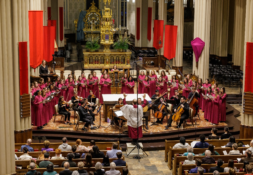Recent stage adaptation’s modernization of the Biblical narrative
For the unknowing attendant, the recent performance of “Christ’s Passion: The Medieval Mystery Plays,” might have come as quite a shock. They were, for this author, the source of much reflection. For those who did not attend the performance and wonder why a show with the word “medieval” could invoke any sort of controversy, herein follows a brief overview of the performance. The production was based on medieval interpretations of prominent Biblical passages which display a Biblical journey from Creation to Doomsday, including the fall of Lucifer, Garden of Eden, Noah’s flood, and the life of Christ. However, anybody from the medieval era would have trouble identifying with the performance, except for a scene which featured a medieval pageant wagon as a background.
The costuming and set were meant to reflect a “steampunk” aesthetic in order to invoke a “post-apocalyptic” ambience. It featured elements such as glowing angel wings crafted from empty water-bottles, ripped, dark clothing, erratic hair styling, the character of God adorned with a large light-up letter “G” around his neck, and a Jesus in tie-dyed shirt. Though the curious post-apocalyptic creative choice was carried out to a degree of perfection reflected in the set and costuming, and though the acting, on the whole, was wonderful, the attempt to use the mystery plays to connect with a “modern” audience fell short.
There is nothing particularly shocking about bringing the Bible into a modern context. The original medieval mysteries are themselves interpretations employing then contemporary modern dress and language. All artistic representations of the Bible, in fact, are the artist’s interpretations what he or she reads in the text in conversation with the influences of the ar time in which the artist lives.
This performance was not controversial because it used modern-day motifs and post-apocalyptic aesthetics, but because the elements of modernity woven into the show were themselves controversial. For example, photographs of a decimated Syria during the scene of Christ’s Passion and Satan having a dual role as President Trump added a modern political undertone to a sacred work. The Bible, a religious text, is perhaps not the most appropriate medium on which to project a controversial political agenda.
This political motif, in conjunction with the inclusion of crass elements of modernity, made the play borderline uncomfortable and, at times, downright confusing for the viewer. The nature of the Bible allows individuals, in any time period, to interpret and re-interpret the passages in a wide variety of mediums, with a great array of themes, and with many different sentiments. This creative license, however, does not mean that an interpreter should divorce the Bible from the Bible’s inherent religiosity.
This play, though provocative, neglected to “connect” with a modern audience because it displayed only the profane elements of modernity. Instead of using a modern lens to interpret the Bible, it seemed as though the performance used the Bible to interpret modernity. The phrase “#killJesus,” the admittedly creative yet disconcerting “temptation in the garden” scene employing fruit to make sexual allusions, and other such artistic choices made the performance seem more akin to a dark and whimsical social commentary than a modern-day stage interpretation of the Bible. Instead of adding a new angle from which to view the Biblical story, the performance gave the viewer a new lens through which to view modernity by taking a sacred text and dragging it through the low-culture of today’s society.
Emily Normand is a first-year PLS major who hails from Phoenix, Arizona, but currently resides in Redding, California. She is interested in traveling the world, but until those travels commence she is happy to live in Lyons Hall and take in all the wonderful things and people Notre Dame has to offer. You can contact her at enormand@nd.edu






Leave a Reply